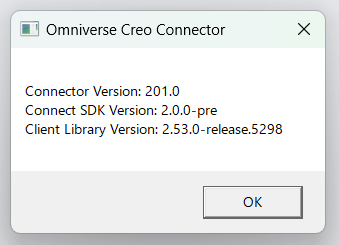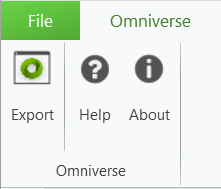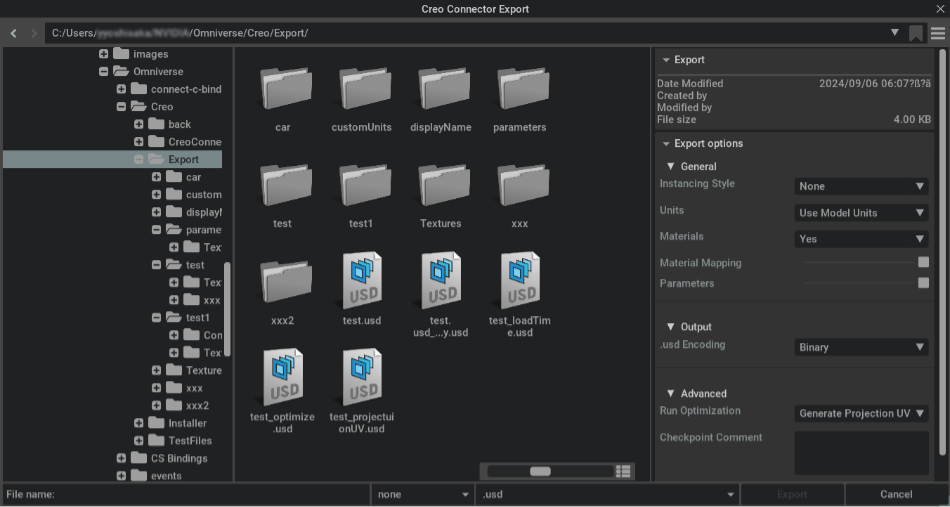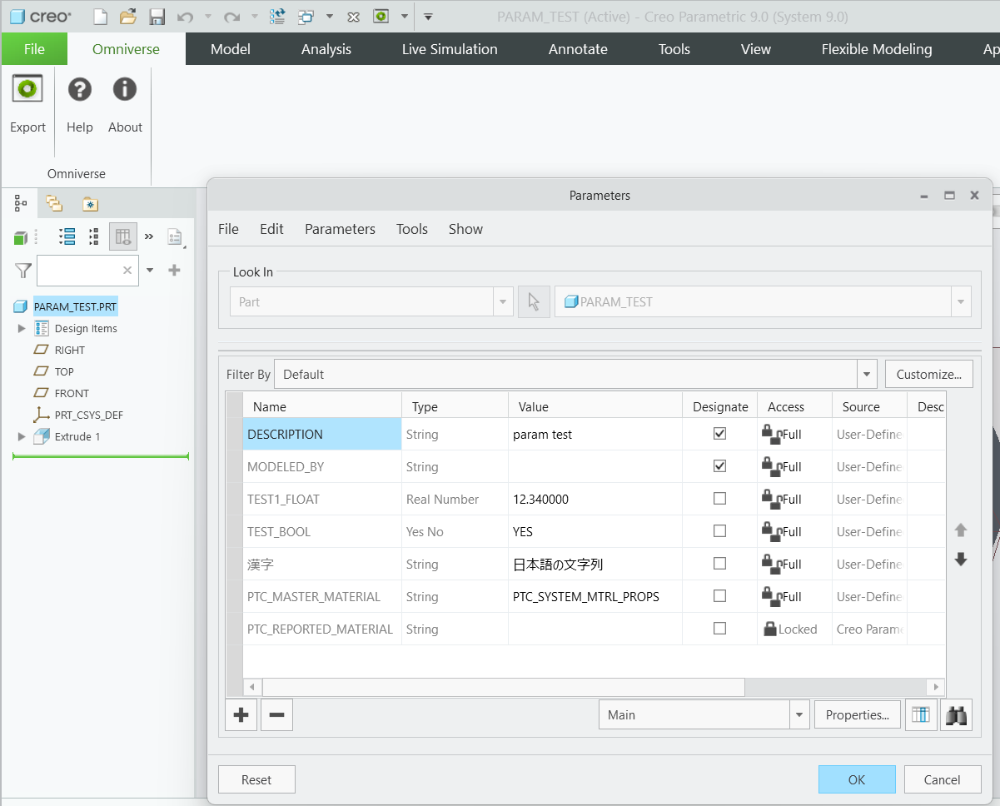User Manual#
User Interface#
The Omniverse Creo Connector brings PTC Creo into the NVIDIA Omniverse™ Platform through the use of NVIDIA Omniverse™ Connect tools similar to other NVIDIA Omniverse™ Connect applications.
The Omniverse menu in PTC Creo is not visible in the user interface until PTC Creo data has been loaded.

Clicking this menu will reveal the ribbon panel for Omniverse Interactions.
Option |
Description |
|---|---|
Export |
Opens the export UI. |
Help |
Directs users to this page. |
About |
Displays version and other useful information regarding the Omniverse Creo Connector. |
About#
Simple informational dialogue displaying relevant Omniverse Creo Connector version information.

Export#
Opens the export UI, from which you can configure and launch your export.
Simply press the export button to reveal the configuration window:

You can select your location to export by selecting the Select Output Directory button, and configure your export settings.

Option |
Description |
|---|---|
Instancing Style |
Displays version and other useful information regarding the Omniverse Creo Connector. |
Units |
The unit system you want your export to be in. Set to Use Model Units to use the model’s native units. |
Materials |
Whether or not to export MDL and UsdPreviewSurface materials embedded in your .usd file. |
Material Mapping |
Whether or not to enable to the material mapping feature. |
Parameters |
The parameters of assemblies and parts are exported as usd attributes. |
Convert Visible Only |
Whether to convert only geometry with visibility true and skip hidden. |
Run Optimization |
Whether or not to run scene optimization on the exported file. |
Checkpoint Comment |
An optional message which is displayed with the checkpoint indicated the completed export of this model. |
Select Output Directory |
Allows you to choose a local or Nucleus Server folder where your exported files will be saved. |
Instancing Style#
Creo models are often assemblies containing many assemblies and parts. This setting configures how the multiple use of assemblies and parts are handled:
None: The model is “flatly” exported into a single file, where every part instance has its own unique polymeshes.
Internal: Parts and assemblies are converted once within the file and are instanced everywhere they are used.
External: Parts and assemblies are converted once as separate USD files residing at the Components folder beside the exported file, and referenced as payloads.
Note
Flexible components, or components which share the same underlying part or assembly but have modifications when instanced, may not export correctly when using Internal or External instancing. If your model’s components do not export as expected, we recommend using the None setting to ensure the correct conversion of such parts.
Units#
Sets the MPU (meters per unit) unit system of the exported file.
Materials#
When enabled, MDL and UsdPreviewSurface materials are created for your meshes. If disabled, only the mesh’s display color is exported.
Material Mapping#
Rather than creating new materials on every export, users can correspond their premade MDL materials in Omniverse to their Creo materials and assign them automatically on export.
When the connector is installed, a file is copied to the path:
\Users\[username]\Documents\Omniverse\Creo\MaterialMapping\omniverseMDLtable.csv
This table maps material names in Creo to corresponding sample materials in your installation of Omniverse Nucleus.
When the Material Mapping feature is enabled, meshes with the materials in the first column of this map will not convert their materials into MDL and UsdPreviewSurface materials. Instead, they will reference the material linked in the second column with the MDL subidentifier denoted in the third.
Users can add their own mappings by duplicating this table.
Note
We recommend duplicating this table rather than editing it as installs and updates of the Creo Connector may overwrite this file.
Parameters#
The parameters of assemblies and parts are exported as usd attributes. The default is disabled.
Creo can store parameters of type String, Integer, Real Number, Yes No in parts and assemblies.

If you enable the ‘Parameters’ checkbox when exporting, they will be output as prim attributes in usd.

The attribute name is prefixed with the ‘omni:creo’ namespace, like ‘omni:creo:[name]’.
Attribute names are given the same naming rules as prim, and if they cannot be expressed that way, the DisplayName is assigned the original name.
Convert Visible Only#
When enabled, only visible geometries will be converted and invisible geometries will be skipped. When disabled, all geometries will be converted and the invisible ones will be set to hidden.
Run Optimization#
Scene Optimization utilizes core optimization libraries found in the Scene Optimizer Kit Extension that performs scene optimizations at the USD level. This allows complex scenes to be converted into more lightweight representations which can be displayed and evaluated more quickly.
The integration provides various processes which can be used individually or in combination stack to optimize a scene. A few base configurations have been provided in the connector to optimize the data prior to sending to your preferred Kit Application.
Users can add their own scene optimizer configurations by adding .json files to this path of their connector installation:
\Users\[username]\AppData\Local\ov\pkg\creo-connector_[Creo Version]_[Connector Version]\connect_scene_optimizer_configs
Please see the Scene Optimizer user manual for information on the optimization operations and how to create custom configuration files.
Checkpoint Comment#
You can provide an optional message which is displayed with the checkpoint indicated the completed export of this model and is viewable with Omniverse Kit UIs and other Omniverse applications.
Logging#
You can troubleshoot exports by viewing the logs created at this path:
\Users\[username]\.nvidia-omniverse\logs\connect-sdk\Creo-[Connector Version]\omni.connect.ptccreo-[Connector Version]
To change log verbosity, you can edit the .toml file at this path:
\Users\[username]\AppData\Local\ov\pkg\creo-connector_[Creo Version]_[Connector Version]\config\omni.connect.client.toml
Find the following within the .toml file and set channels.”” = * to Error, Warning, Info or Verbose.

Note
Decreasing severity will increase the amount of log output. Setting to “Error” will result in only logging Errors, whereas setting it to “Verbose” will log everything.
Selecting Export Location#
When you click the Select Output Directory button, the OmniBrowser File Dialog opens, allowing you to choose where to export your converted USD file.
You have two options for selecting your export destination:
Local File System: Browse and select any folder on your local computer by navigating through the directory tree on the left side of the dialog.
Nucleus Server: Click the Add or Change Server button to connect to an Omniverse Nucleus server by providing an omniverse nucleus URL. Once connected, you can browse and select folders on the server.
After selecting your desired project folder, enter the name for your output file in the Output Filename text field at the bottom of the dialog. Once both the folder and filename are specified, click OK to confirm your selection.

Note
If no file extension is provided to the output filename (e.g., .usd, .usda, .usdc), the default extension .usd will be added to the output file name.
Converting from the Command Line#
Users can also use the command line to convert their Creo models by running the provided convert.bat located at the installation location of the connector. Arguments largely correspond to options in the export window.
Usage:
[Path_to_creo_connector_install]\convert.bat [Path_to_creo_parametric_exe] [Arguments_semicolon_separated]
Example:
convert.bat "C:\Program Files\PTC\Creo 8.0.0.0\Parametric\bin\parametric.exe" --file C:\Dev\tests\inputs\Creo8\centeredblock.prt;--output C:\Dev\tests\outputs\Creo8;--extension .usdc
This will export the centeredblock.prt file to C:\Dev\tests\outputs\Creo8\centeredblock.usdc.
Required Arguments:#
Arg |
Description |
Possible Values |
|---|---|---|
–file |
The full path to the file to convert. |
Any file path without whitespace ending strictly in .prt or .asm |
–output |
The directory to output to. Filename will match the input file’s name. |
Any valid directory path |
–extension |
Export file extension. |
.usd, .usda, .usdc |
Note
Path arguments cannot contain any whitespace, and versions in file extensions such as .5 in .prt.5 must be omitted when using this feature.
Optional Arguments:#
Arg |
Description |
Possible Values |
|---|---|---|
–unitSystem |
The unit system you want your export to be in. Set to Use Model Units to use the model’s native units. |
See https://openusd.org/release/api/class_usd_geom_linear_units.html |
–instancingStyle |
Displays version and other useful information regarding the Omniverse Creo Connector. |
External, Internal, None |
–exportMaterials |
Whether or not to export MDL and UsdPreviewSurface materials embedded in your .usd file. |
True, False |
–materialMapping |
Whether or not to enable to the material mapping feature. |
True, False |
–parameters |
Whether or not to enable to exporting of parameters. |
True, False |
–convertVisibleOnly |
Whether or not to convert only visible geometries. |
True, False |
–optimize |
Path to scene optimization file. |
Any file path to a valid scene optimization .json file |
–comment |
An optional message which is displayed with the checkpoint indicated the completed export of this model. |
Any text |
Recreating the Shortcut#
If you lose your shortcut, you can simply reinstall the connector, or follow the steps to recreate the desktop shortcut manually:
Right click on your desktop (or any folder)
New / shortcut
Set the location to your creo install folder (path above)/launch_creo.bat
Finish creating the shortcut
Right click on the new shortcut and hit Properties
Change the Start-in path to the install folder of your connector install (path above)